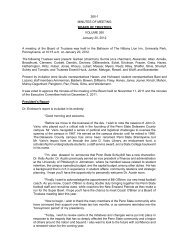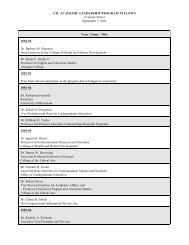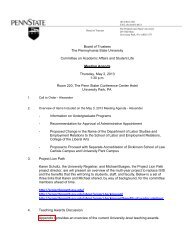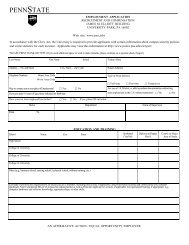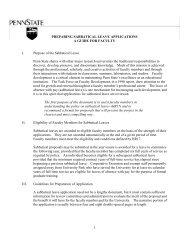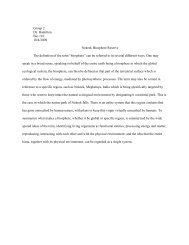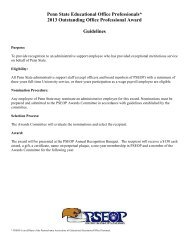Managing Disruptive Behavior - Penn State University
Managing Disruptive Behavior - Penn State University
Managing Disruptive Behavior - Penn State University
Create successful ePaper yourself
Turn your PDF publications into a flip-book with our unique Google optimized e-Paper software.
If these types of behavior are having a negative impact, the employee initially should request<br />
that the behavior cease or be modified. Only in those cases when a person refuses to respond<br />
and his/her behavior becomes further disruptive would additional action be appropriate.<br />
<strong>Disruptive</strong> <strong>Behavior</strong>. When a person’s behavior results in some disruption of the workplace/<br />
community, additional steps may be necessary in response. <strong>Penn</strong> <strong>State</strong>’s Code of Conduct<br />
defines disruption as “. . . an action or combination of actions by one or more individuals that<br />
unreasonably interferes with, hinders, obstructs, or prevents the operation of the <strong>University</strong> or<br />
infringes on the rights of others to freely participate in its programs and services.” <strong>University</strong><br />
Code of Conduct, 2007.<br />
When assessing whether or not behavior is disruptive, the immediate and practical<br />
consequences of the conduct should be considered as well as whether it interferes with unit<br />
or academic operations or prevents others from participating fully in those activities. <strong>Disruptive</strong><br />
behavior should be confronted quickly and calmly by an employee. In most cases, simply<br />
making individuals aware of their behavior will resolve the situation. (Note: student workers may<br />
be reluctant to confront peers; however, they should be expected to confront disruptive behavior<br />
in the absence of full-time staff.)<br />
When behavior is determined to be disruptive, if appropriate and possible, a conversation<br />
should be initiated with the person in a private area unless there are safety concerns. When<br />
responding to disruptive conduct, the employee should:<br />
• speak calmly and explain to the person the behavior viewed as disruptive and/or<br />
interfering with the learning process (or in some cases, posing a risk to <strong>University</strong><br />
personnel and/or facilities), and ask them to stop<br />
• focus on behavior, not individuals or traits, and avoid personal accusations and threats<br />
• if necessary, explain that others, such as a supervisor or the police, may be informed,<br />
making clear that this possibility is being noted for the person’s consideration and<br />
that behavior will determine the course of action<br />
• listen to what the person is saying and acknowledge any concerns she or he may<br />
raise<br />
• when possible, suggest options to resolve the situation without further disruption or<br />
formal action (stay within own expertise)<br />
• look for others to assist if uncomfortable confronting behaviors alone<br />
• consider contacting <strong>University</strong> Police or the appropriate police agency serving the<br />
campus if the behavior persists and the disruptive person refuses to cooperate with<br />
clearly stated requests<br />
If the disruptive person is a student and the behavior is not considered threatening, the employee<br />
may explain to the student that a report will be submitted to the unit supervisor who may<br />
also wish to involve the Office of Judicial Affairs. Faculty have the authority to request a disruptive<br />
student to leave class but not to expel or force a student to drop a class on a temporary<br />
or permanent basis; this can only be done through the Office of Judicial Affairs. If the student<br />
becomes combative or the behavior escalates, the police should be called.<br />
(2)



